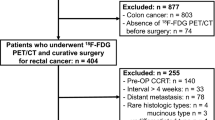Abstract
The aim of this study was to assess the value of fluorine-18 fluoro-2-deoxyglucose (FDG) positron emission tomography in patients with recurrent rectal cancer, in relation to tumour size and cellularity. Thirty-seven patients (21 mean and 16 women; mean age, 55.4±9.58 years) with suspected recurrence of rectal cancer were studied. FDG uptake was quantified by the differential absorption ratio (DAR). In 29 patients magnetic resonance imaging was also performed. To evaluate the signal intensity of the lesion, the lesion to muscle signal intensity ratios (SIR) were calculated on T2-weighted images. In seven patients who received surgical treatment the DAR and SIR were compared with the tumour cellularity. All 32 patients with confirmed recurrence showed increased FDG accumulation in the mass (DAR=4.57±1.89) in comparison with low FDG accumulation in five patients with scar (DAR=1.17±0.43). There was a significant correlation (r=0.661,P<0.001) between the DAR and the tumour diameter. There was no correlation between the DAR and SIR, whereas there was a significant correlation (r=0.565,P<0.01) between the DAR corrected using count recovery coefficient (DAR*) and SIR. In the histopathological findings there was a tendency for the DAR* and SIR to correlate with tumour cellularity. It is concluded that the DAR of recurrent rectal cancer should be evaluated taking into consideration the tumour size and cellularity.
Similar content being viewed by others
References
Som P, Atkins HL, Bandoypadhyay D, et al. A fluorinated glucose analog, 2-fluoro-2-deoxy-d-glucose (F18): non-toxic tracer for rapid tumor detection.J Nucl Med 1980; 21: 675.
Straus LG, Conti PS. The application of PET in oncology.J Nucl Med 1991; 32: 623–648.
Wahl RL, Hawkins RA, Larson SM, et al. Proceedings of a National Cancer Institute workshop: PET in oncology - a clinical research agenda.Radiology 1994; 193: 604–606.
Golgberg MA, Lee MJ, Fishman AJ, Muller PR, Alpert NM, Thrall JH. Fluorodeoxyglucose PET of abdominal and pelvic neoplasms: potential role in oncologic imaging.Radiographics 1993; 13: 1047–1062.
Straus LG, Clorius JH, Schlag P, et al. Recurrence of colorectal tumors: PET evaluation.Radiology 1989; 170: 329–332.
Ito K, Kato T, Tadokoro M, et al. Recurrent rectal cancer and scar: differentiation with PET and MR imaging.Radiology 1992; 182: 549–552.
Bares R, Klever P, Hellwig D, Hauptmann ST, Fass J, Hambuchen U, Zopp L, Muller B, Buell U, Schumpelic V. Pancreatic cancer detected by positron emission tomography with18F-labelled deoxyglucose: method and first results.Nucl Med Commun 1993; 14: 596–601.
Kato T, Fukatsu H, Ito K, et al. Fluorodeoxyglucose positron emission tomography in pancreatic cancer: an unsolved problem.Eur J Nucl Med 1995; 22: 32–39.
Inokuma T, Tamaki N, Torizuka T, et al. Value of fluorine-18-fluorodeoxyglucose and thallium-201 in the detection of pancreatic cancer.J Nucl Med 1995; 36: 229–235.
Wahl RL, Cody RL, Huchins GD, Mudgett EE. Primary and metastatic breast carcinoma: initial clinical evaluation with PET with the radiolabelled glucose analog 2-[F-18]-fluoro-2deoxy-d-glucose.Radiology 1991; 179: 765–770.
Dewan NA, Gupta NC, Redepenning LS, et al. Diagnostic efficacy of PET-FDG imaging in solitary pulmonary nodules. Potential role in evaluation and management.Chest 1993; 104: 997–1002.
Kubota K, Matsuzawa T, Fujiwara T, et al. Differential diagnosis of lung tumor with positron emission tomography: a prospective study.J Nucl Med 1990; 31: 1927–1933.
Okada J, Yoshikawa K, Imazeki K, et al. The use of FDG-PET in the detection and management of malignant lymphoma: correlation of uptake with prognosis.J Nucl Med 1993; 32: 686–691.
Braans JW, Pruim J, Freling NJM, et al. Detection of lymphnode metastasis of squamous-cell cancer of the head and neck with FDG-PET and MRI.J Nucl Med 1995; 36: 211–216.
Di Chiro G, DelaPaz RL, Brooks RA, et al. Glucose utilization of cerebral gliomas measured by18F-fluorodeoxyglucose and positron emission tomography.Neurology 1982; 32: 1323–1329.
Aldler LP, Blair HF, Makley JT, et al. Non-invasive grading of musculoskeletal tumors using PET.J Nucl Med 1991; 32: 1508–1512.
Ido H, Wan CN, Fowler JS, Wolf d AP. Fluorination with F2: a convenient synthesis of 2-deoxy-2-fluoro-glucose.J Org Chem 1977; 9: 931–939.
Ehrenkaufer RE, Potocki JF, Jewett DM. Simple synthesis of F-18-labeled 2-fluoro-2-deoxy-d-glucose: concise communication.J Nucl Med 1984; 25: 333–337.
Iida H, Miura S, Kanno J, et al. Design and evaluation of Headtome-IV, a whole body emission tomograph.IEEE Trans Nucl Sci 1989; 36: 1006–1010.
de Lange EE, Fechner RE, Wanebo HJ. Suspected recurrent rectosigmoid carcinoma after abdominoperineal resection: MR imaging and histopathologic findings.Radiology 1989; 170: 323–328.
Higashi K, Clavu AC, Wahl RL. Dose FDG uptake measure the proliferative activity of human cancer cells? In vitro comparison with DNA flow cytometry and tritiated thymidine uptake.J Nucl Med 1993; 34: 414–419.
Kubota R, Yamada S, Kubota K, Ishiwata K, Tamahashi N, Ido T. Intratumoral distribution of fluorine-l8-fluorodeoxyglucose in vivo: high accumulation in macrophages and granulation tissues studied by microautoradiography.J Nucl Med 1992; 33: 1972–1980.
Lindholm P, Minn H, Leskinen-Kallio S, Bergman J, Ruotsalainen, Joensuu H. Influence of the blood glucose concentration on FDG uptake in cancer — a PET study.J Nucl Med 1993; 34: 1–6.
Author information
Authors and Affiliations
Rights and permissions
About this article
Cite this article
Ito, K., Kato, T., Ohta, T. et al. Fluorine-18 fluoro-2-deoxyglucose positron emission tomography in recurrent rectal cancer: relation to tumour size and cellularity. Eur J Nucl Med 23, 1372–1377 (1996). https://doi.org/10.1007/BF01367594
Received:
Revised:
Issue Date:
DOI: https://doi.org/10.1007/BF01367594




